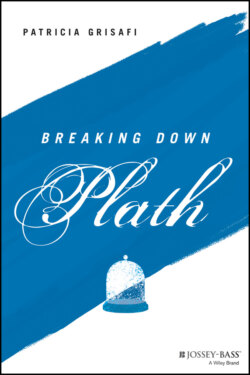Читать книгу Breaking Down Plath - Patricia Grisafi - Страница 9
Introduction
ОглавлениеWhen I was a sophomore in high school, I couldn't wait to study Sylvia Plath. I had been reading her work on my own for years and was excited to finally get the chance to dig in with my teacher and fellow students. In the massive Modern American Literature textbook, though, there was only one Plath poem: “Mirror.” It's a fine poem, but it's short and safe; it doesn't ruffle any feathers. Our teacher discussed its themes, talked a little bit about Plath's life, and mentioned that she “died young.” That was it.
I couldn't believe it. In a classroom where we studied at least ten Robert Frost poems and seemingly everything Ralph Waldo Emerson wrote, couldn't we at least read one more Plath poem? (No disrespect to Mr. Frost and Mr. Emerson, of course.)
Today, Sylvia Plath is everywhere. Her name has its own connotation—we associate “Plathian” with anything dark, witty, and shocking. You can buy Sylvia Plath magnets for the fridge and Sylvia Plath socks for a cold night. Plath quotes make good T‐shirt designs. There is an Instagram account dedicated to fans who have gotten Plath tattoos. Lady Gaga and Lana Del Rey, among other musicians, have referred to her in their songs. A 2003 movie was made about her starring Gwyneth Paltrow. Plath is also often mentioned in films focused on teenagers. For example, in Spider‐Man: Homecoming (2017), MJ (played by Zendaya) is wearing a Plath T‐shirt. It functions as a shortcut to understanding MJ's personality: She's a little morbid, no‐nonsense, and into female empowerment.
While Sylvia Plath is now so well‐known she's actually become commoditized, it wasn't always that way. When she died, she was not a household name—not even close. It wasn't until the posthumous publication of Ariel that she became iconic. Over the years, the ways we approach Sylvia Plath's work have shifted, which allows her reputation as an integral writer in American literature to grow. Despite the near‐mythological status she now occupies across film, fashion, and digital media, Plath was first and foremost a woman who wrote. Plath viewed herself as a writer from a young age, and her identity intertwined with writing for her whole life. In a journal entry she wrote at age seventeen, Plath called herself “the girl who wanted to be God”—a phrase that speaks to her ambitious nature.
Plath had many identities—some contradictory. She was a dutiful daughter who also struggled to liberate herself from her family. She was a hard‐working and brilliant student who enjoyed parties and fashion. She was an expatriate—an American who moved to England. She was a wife who wanted to get out of her husband's shadow. She was a mother who wanted to be seen as both a loving parent and a successful career woman. And she was a person who lived with mental illness and died by suicide.
Plath has always spoken to young people, people who feel disenchanted with their world, people who feel deeply and are passionate about life, who feel like they don't belong. She taps into our rage and our joy in a unique way. When I was that disappointed high school student who wanted more Plath and less Emerson, I wondered why the teachers kept her from us. Was she too intense? Too taboo? Not appropriate for high school students? Why did we read The Catcher in the Rye and not The Bell Jar?
It turns out Plath is more than appropriate—she is necessary. In our contemporary moment, which shares many uncomfortable commonalities with Plath's World War II and Cold War upbringing, Plath's voice is more urgent than ever. For those struggling with mental health issues, she reminds us that we can choose how to define ourselves and our disabilities. For those angry about the prevalence of rape culture, she reminds us that our voices matter and that they can give us power. For those who feel like they don't belong, she reminds us that we can find our people. She reminds us that the personal is still political, that the political is also personal.
